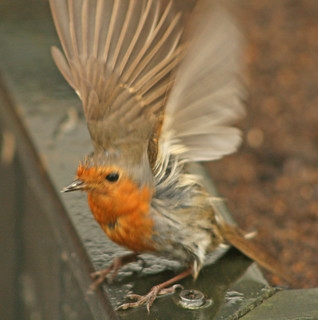Highlights
Results on birds' proposed quantum vision fly apart
In a 2011 paper, researchers from the Centre for Quantum Technologies reached the startling conclusion that birds, to detect magnetic fields, may exploit quantum states with lifetimes rivalling those seen in the most protected laboratory environments. Now another set of CQT researchers using the same model but different reasoning has predicted much shorter coherence times for the implicated states. The new paper, like the previous one, is published in Physical Review Letters.
"It's a scientific debate," says Dagomir Kaszlikowski, CQT Principal Investigator, and one of three authors on the new paper, which relies on experimental observations not included in the first work. A report appears on the Physics World news site.
That debate exists is hardly surprising: even the basic biology of how birds detect magnetic fields is something of a muddle. The skill is thought to help them on their long migrations, but little is known about how they do it. Theories range from birds having specialised cells containing magnetised particles to chemical processes in the eye's retina.
The earlier prediction for the involvement of long-lived quantum state was interesting not only for bird-lovers, but also for the growing numbers of researchers investigating the idea that life may exploit quantum phenomena. Sceptics of 'quantum biology' point out that delicate quantum states would not be expected to survive for long in the noisy environment typical of life — a point of view this work brought into question.
Both CQT papers analysed data from experiments on European robins assuming a particular model for magnetoreception known as the radical pair mechanism. This popular model holds that an unidentified magnetoreceptor molecule in the retina — suspicion falls on a molecule called cryptochrome — is excited by light to form a 'radical pair'. The external magnetic field would determine what proportion of the excited molecules end up in a 'spin-triplet' versus a 'spin-singlet' state, with dependence on the relative angle between the field and the molecule. The two states might decay either into different chemical products that allow the bird to sense the orientation of the field or, as a team involving CQT researchers proposed earlier this year year, influence vision via the triplet state's electric field.
Experiments showing that European robins become disoriented when exposed to an oscillating magnetic field give hints on how long these singlet and triplet states would need to last. The two papers differ in how they analyse the data. In the first, Erik Gauger, a CQT and University of Oxford Research Fellow, and his coauthors developed a model that allowed them to calculate how long the state must live to avoid the oscillating field washing out the angular dependence entirely.
In the 2012 paper, Dagomir and his coauthors consider the additional experimental observation that the birds became disoriented if the field they were exposed to was more than 30% weaker than the Earth's field. Instead of looking at angular dependence, they used this data to identify a 'functional window' for the birds to sense the singlet/triplet state ratio, and calculated for what state lifetime the singlet/triplet response would still fall within this window.
Whereas the first approach gives a lifetime up to 100 microseconds, the second suggests lifetimes only up to around 10 microseconds. Dagomir and his co-authors note that this is in line with results from in-vitro experiments on the lifetime of excited states of cryptochrome molecules. They also make the interesting observation that the presence of environmental noise, which shortens the state's lifetime, can increase the angular dependence of the response. That could equate to increased sensitivity in a noisy environment — and the possibility that the biology had evolved to best match its environment.
So which paper is right? Erik says he has reservations about relying on the observations of bird behaviour in the 30% weaker field, since few details were provided in the original experimental papers, and says other observations not included in the new analysis might increase the predicted lifetime. He plans to run some new calculations of his own. Dagomir welcomes the scrutiny: his own team's work was motivated by the idea that it's important to challenge assumptions, particularly for extraordinary claims.
"Experiments directly on the compass molecule would be the best way of establishing the lifetime but there are two challenges. Firstly the result will probably strongly depend on the environment, so an in vivo setting is required. Secondly, the compass molecule has not yet been identified. Cryptochrome might more or less fit the bill, but at this point it remains speculation," says Erik.
And on that point, both teams agree. With so much uncertainty about the underlying mechanism and so little data, "it's all speculation," says Dagomir.
Dagomir's co-authors on the paper are CQT alumnus Jayendra Bandyopadhyay, now at Birla Institute of Technology and Science, India, and CQT Research Assistant Professor Tomasz Paterek, who is also an Assistant Professor at Singapore's Nanyang Technological University. The article is published as "Quantum Coherence and Sensitivity of Avian Magnetoreception", Phys. Rev. Lett. 109, 110502 (2012); arXiv:1204.6528.







